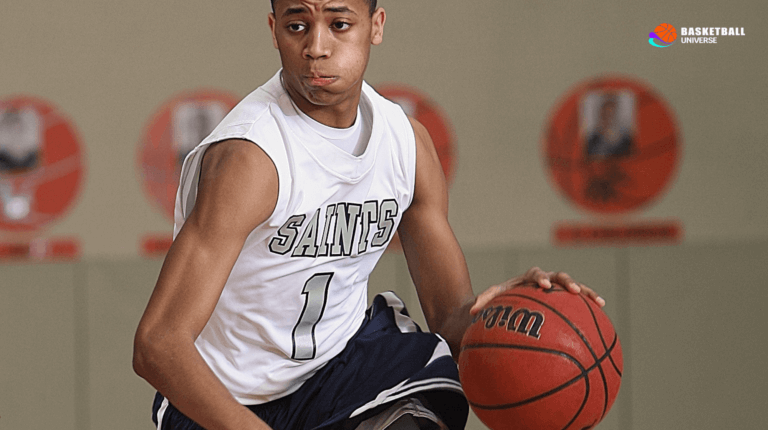
How to Lower a Basketball Hoop?
Written by: Basketball Universe
Last updated:

Welcome to the ultimate guide on “How to Lower a Basketball Hoop?”! Whether you’re a seasoned hoop-shooter wanting to school the kiddos, or simply looking to modify your space for an exciting workout, adjusting your hoop will surely make the sport accessible and fun for every skill level. Journey with us as we unveil tried and tested techniques to lower your basketball system, ensuring a slam-dunk experience for everyone on the court. Let’s gear up for this exciting exploration into the thrilling world of basketball hoop adjustments, so you can start swishing those baskets like a pro!
How to Lower a Basketball Hoop?
To lower a basketball hoop, first identify the type of system you have: in-ground, portable, or wall-mounted. For in-ground and portable systems, locate the adjustment mechanism—either a crank, lever, or broomstick method—and follow the manufacturer’s instructions to change the height. Wall-mounted systems may require additional hardware or brackets for adjustments. Always consult the instruction manual or contact the manufacturer for assistance, if needed.
Understanding the Three Types of Basketball Hoop Systems
In order to effectively lower a basketball hoop, it’s important to understand the three main types of hoop systems: in-ground, portable, and wall-mounted. Each type has its own method of adjustment, and recognizing your hoop’s design will pave the way for a seamless transition to a lower height.
In-Ground Basketball Hoop Systems
In-ground basketball hoop systems are professionally installed by being anchored into the ground. They usually offer the highest degree of stability and support, and tend to require less maintenance. Many in-ground systems come with an adjustable height mechanism, making them popular for accommodating a wide range of players.
Portable Basketball Hoop Systems
Portable basketball hoop systems are designed to be mobile and easy to relocate. Generally, these systems feature a base filled with sand or water to provide stability while in use. Like in-ground systems, the majority of portable hoops come with an adjustable height mechanism, making them a versatile option for families and recreational players alike.
Wall-Mounted Basketball Hoop Systems
Wall-mounted basketball hoop systems are mounted directly onto the wall, garage, or another suitable vertical surface. This type of system saves space, making it an ideal choice for those with limited areas for play. Wall-mounted systems typically require additional hardware or brackets for adjustments and may not be as flexible as in-ground or portable systems when it comes to modifying the height.
Lowering In-Ground and Portable Basketball Hoop Systems
Let’s begin looking at the lowering methods for the most common types of adjustable-height basketball hoop systems: in-ground and portable. By understanding these techniques, you’ll be well on your way to making your basketball hoop the perfect height for your needs. We’ll explore each of these methods in detail, guiding you step by step through the process.
Using a Crank System
A crank system is one of the most popular height-adjustment mechanisms used in adjustable basketball hoop systems. Here’s how to lower a basketball hoop using a crank system:
- Locate the crank handle, which can usually be found on the pole of the basketball system.
- Turn the crank handle counterclockwise to start gradually lowering the height of the hoop. You should feel a slight resistance as you turn.
- Continue cranking until the hoop reaches your desired height. Many systems come with height markings on the pole to help you achieve a precise measurement.
- Once the desired height is reached, ensure the safety mechanism (such as a pin) is properly secured to prevent unwanted height changes during play.
Using a Lever System
A lever system is another common height-adjustment mechanism. It functions using hydraulics or a spring-assisted mechanism, making it easier to adjust the height quickly. Here’s how to lower a hoop using a lever system:
- Locate the height adjustment lever, typically found near the pole.
- Release the safety mechanism, which could be a push button, pin or threaded lock.
- While holding the lever, gently apply pressure downwards or towards you to lower the hoop, allowing the hydraulics to control the lowering speed.
- Once you have reached the desired height, re-engage the safety mechanism to secure the hoop in place and prevent accidental changes in height during use.
Using a Broomstick Method
Also known as a manual adjustment method, the broomstick method is a more hands-on approach and often found in older or simpler adjustable basketball systems. Here’s how to lower a hoop using the broomstick method:
- Locate the release latch, commonly found on one side of the system’s pole.
- With a broomstick or long object, apply pressure on the release latch to disengage the height lock.
- While continuing to apply pressure on the latch, gently push the backboard downward with the broomstick until it reaches the desired height.
- Release the latch, ensuring it locks securely into place to hold the new height setting during play.
Adjusting Wall-Mounted Basketball Hoop Systems
Wall-mounted basketball hoop systems offer space-saving benefits, but adjusting their height can be somewhat more complex. Here, we’ll delve into the necessary steps and potential hardware adjustments required to lower your wall-mounted hoop effectively.
Modifying the Mounting Bracket Position
When lowering a wall-mounted basketball hoop system, you’ll often need to modify the mounting bracket position. Here’s how:
- Detach the basketball hoop from the mounting bracket system with the appropriate tools. This step typically requires a wrench or socket set.
- Position the mounting bracket lower on the wall in your desired location, ensuring it’s still attached securely to a solid surface. Flags or adjustment marker lines are often included to help place the bracket accurately.
- Use a level to ensure the mounting bracket is perfectly horizontal and adjust as needed.
- Refasten the basketball hoop to the new mounting bracket location, taking care to tighten all bolts and nuts securely.
Using an Extension Arm with Adjustability Features
An alternative way to adjust the height of a wall-mounted hoop is to purchase and install an extension arm with built-in adjustability features. These extension arms often include mechanisms such as telescoping poles or rear adjuster dials to enable straightforward height modifications without having to move the mounting brackets.
Maintaining Safety When Lowering Your Basketball Hoop
While it’s essential to lower your basketball hoop properly, ensuring the safety of all players is equally crucial. Here, we’ll share key safety tips to remember while adjusting the height of your hoop:
- Always consult the manufacturer’s instructions or user manual for specific adjustment guidelines pertaining to your basketball system.
- If you’re unsure of the proper method or require assistance, reach out to the manufacturer or a qualified professional.
- Observe all recommended age restrictions and height guidelines, especially when the hoop will be used by children.
- Confirm that the hoop is properly secured at the desired height, and ensure any safety mechanisms — such as pins or locking systems — are correctly engaged.
By following these safety precautions when adjusting the height of your basketball hoop, you can help create a fun environment for everyone while they enjoy the game of basketball.
Preparing to Adjust Your Basketball Hoop
Before diving into the process of lowering your basketball hoop, it’s essential to prepare and gather necessary equipment, ensuring a smooth and efficient height adjustment. Here are some useful tips to keep in mind:
- Gather tools recommended by the manufacturer, such as wrenches or a broomstick, and keep them close at hand.
- Prioritize working on a calm day, as strong winds can make handling the backboard and hoop difficult and dangerous.
- Enlist the help of a friend or family member to assist with the process, especially if you are adjusting a heavy or large backboard.
- Clear the area of any obstacles that could potentially cause a fall or injury, and maintain a clean, flat surface for working.
Checking NBA and NCAA Height Regulations
While adjusting your basketball hoop to a lower height can make the game more accessible and enjoyable for players of different skill levels, it’s important to keep the official regulations in mind if you ever plan to participate in leagues or competitive play. Both the NBA and NCAA basketball standards require hoops to be set at a height of 10 feet.
If you’re lowering your hoop to practice specific techniques or make the game more engaging for younger players, it’s advisable to eventually practice with a 10-foot hoop to familiarize yourself with the official height requirements.
Achieving the Ideal Basketball Hoop Height for Kids
Understanding the ideal basketball hoop height for children is crucial, as it can help promote proper development of shooting form and overall enjoyment of the game. The following guidelines can be helpful:
- Ages 5-7: Set the hoop at a height of 6-7 feet.
- Ages 8-11: Set the hoop at a height of 8-9 feet.
- Ages 12-15: Set the hoop at a height of 9-10 feet, as their skills progress.
Keep in mind that these are merely guidelines, and it’s essential to consider the individual needs and abilities of each child when adjusting the height of your basketball hoop.
Basketball Hoop Maintenance and Care
Maintaining and caring for your basketball hoop is important to ensure longevity and safe play. Here are some tips to help you keep your hoop in top condition:
- Inspect your basketball system regularly for any signs of wear, rust, or damage.
- Tighten and secure any loose bolts and nuts found during inspections.
- Check the net for fraying or other damage, replacing it when necessary.
- Clean the backboard with mild soap and water, taking care not to use abrasive cleaners that could damage the surface.
- For in-ground systems, verify pole stability and check for any signs of ground erosion that could compromise the hoop’s foundation.
Implementing these maintenance practices will ensure that your basketball hoop remains a safe and enjoyable part of your recreational activities for years to come.
Frequently Asked Questions
When it comes to lowering basketball hoops and basketball systems in general, we understand that you may have additional questions. To provide you with even more helpful information, we’ve compiled a list of common questions and answers related to the topic.>
Why do I need to lower my basketball hoop?
Lowering a basketball hoop can make the game more accessible and enjoyable for players with varying skill levels or height, especially for children who are learning the sport. It can also make it easier to practice specific techniques or training drills.
What is the standard height for a basketball hoop?
The official height for NBA and NCAA-regulated basketball hoops is 10 feet from the ground to the top of the rim.
How do I know if my basketball hoop system is adjustable?
Examine your basketball system for an adjustment mechanism, usually found on the pole or near the backboard. Consult the user manual or reach out to the manufacturer if you’re unsure about your system’s adjustability.
What tools do I need to adjust my basketball hoop?
Depending on your hoop system, you may need wrenches, a broomstick, or other tools specified by the manufacturer. Check the user manual for clear instructions and recommended tools.
What is the ideal basketball hoop height for my child?
For ages 5-7, set the hoop at 6-7 feet. For ages 8-11, set the hoop at 8-9 feet. For ages 12-15, set the hoop at 9-10 feet, adjusting progressively as their skills develop. These are general guidelines and may vary based on individual needs and abilities.
Can I adjust the height of a wall-mounted basketball hoop?
Yes, adjusting a wall-mounted basketball hoop may involve modifying the mounting bracket position or using an extension arm with built-in adjustability features. Wall-mounted hoop adjustments tend to be more complex, so consult the instructions or contact the manufacturer for detailed information.
How do I maintain my basketball hoop system?
Regular inspections and maintenance, such as tightening loose bolts, checking nets, cleaning backboards, and verifying overall stability, will ensure that your basketball hoop system lasts longer and remains safe for use.
Should adults play on a lower hoop?
While it can be fun to play on a lowered hoop occasionally, adults looking to improve their skills or prepare for competitive play should practice with a regulation-height (10 feet) hoop whenever possible.
How can I safely lower my basketball hoop without damaging it?
Follow the manufacturer’s instructions, use the correct tools, and enlist the help of a friend or family member when needed to ensure a safe and damage-free lowering process.
Can two people adjust a basketball hoop together?
Yes, in fact, it can often be safer and more manageable for two people to work together when adjusting a basketball hoop, especially with heavy or large backboards.
My basketball hoop is stuck; how can I fix it?
Consult the user manual or contact the manufacturer for guidance on troubleshooting and resolving any jamming or other issues with your hoop’s adjustment mechanism.
What safety measures should I take when lowering a basketball hoop?
Always consult the manufacturer’s instructions, ensure the hoop is secured at the desired height, engage safety mechanisms, and observe age restrictions and height guidelines when adjusting the height of your basketball hoop.
Are there any alternative basketball systems for those who can’t lower their hoops?
Portable systems or adjustable-height wall-mounted extension arms can be useful alternatives for those who cannot lower their current basketball hoops. These systems offer variable height options and can cater to a wide range of skill levels and age groups.
Featured Posts
- No pillar pages found.





